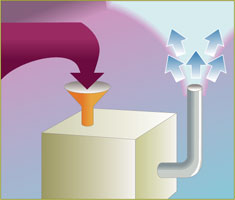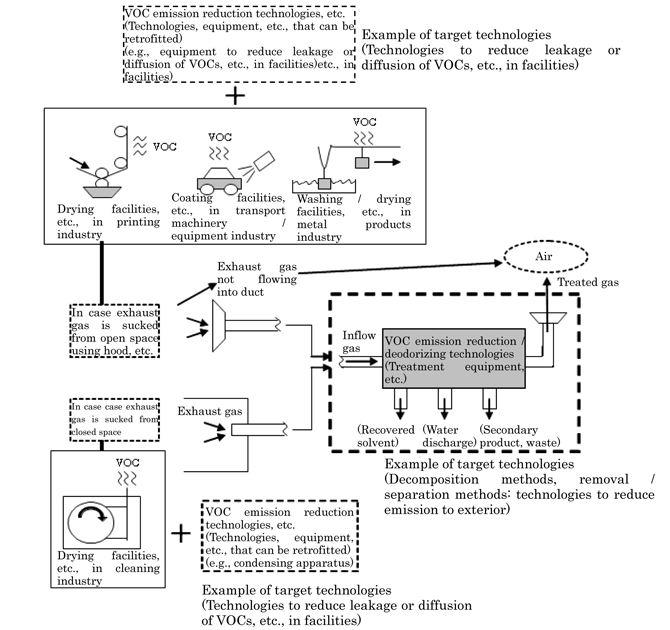Measures against VOCs: VOC Treatment Technologies
 @
@ @
@
@The “VOC Emission Reduction / Deodorizing Technologies” field (VOC Emission Reduction / Deodorizing Technologies for Small / Medium-Scale Establishments) targets “VOC (Volatile Organic Compound) emission reduction technologies” and “deodorizing technologies.” In this field, verification is performed targeting technologies (equipment, plants, etc.) to appropriately treat VOCs and odor materials emitted at facilities concerning coating, printing, industrial washing, cleaning, etc., owned by small / medium-scale establishments (facilities for which voluntary efforts on VOC emission reduction are expected in the Air Pollution Control Act), as well as VOC emission reduction technologies and deodorizing technologies by improving the structure of facilities. Emission reduction / deodorizing technologies of this field include not only total treatment but also partial treatment (conducted by bypass treatment, etc.) and local treatment / emission reduction / deodorizing by improving the structure of facilities. In particular, low-cost, compact, easy maintenance, commercial-ready technologies are targeted. Besides the treatment technologies mainly aiming at reducing and deodorizing emission to the exterior, technologies / equipment to reduce leakage or diffusion into facilities during each working process are included. For example, technologies to recover a solvent by dehydration of wiping rags, distillation, purification, etc.

Figure: Schematic of target verification technologies (within dotted line; equipment to be verified)
About the “VOC Emission Reduction / Deodorizing Technologies” field (VOC Emission Reduction / Deodorizing Technologies for Small / Medium-Scale Establishments)
- VOCs (Volatile Organic Compounds) is the generic name of organic compounds that easily vaporize and become gas in the air, and is one of the substances responsible for suspended particulate matters and photochemical smog. Major VOCs include about 200 types of substances such as toluene, xylene and ethyl acetate, and are emitted in various fields such as industrial washing, printing, adhesive bonding, and chemical industry.
- Because “photochemical smog” had been increasing recently, the Air Pollution Control Act was revised and VOC emission regulations started in 2006. The aim of this revision is to reduce the total VOC emission from fixed sources such as factories by 30% during the period from fiscal 2000 to 2010, by combination (best mix) of regulations based on the law, covering specific fields, and voluntary efforts of enterprises.
- Emission reduction by enclosing facilities or other measures has been conducted in large-scale establishments. However, these measures have not been taken sufficiently in small / medium-scale establishments because of lack of funding, their operation conditions, etc. Complaints about bad smells from small / medium-scale establishments adjacent to living environments are increasing especially in urban areas, and sources of bad smells that cause these complaints come to be diversified. Therefore, it is required to take measures to further promote reduction of VOCs emitted from small / medium-scale factories and establishments. Recently, treatment equipment using VOC treatment technologies has been developed and put into practical use, and in particular, compact treatment equipment has been commercialized that can be introduced to small / medium-scale factories and establishments. However, it has not spread in the market sufficiently because it is not widely known by enterprises.